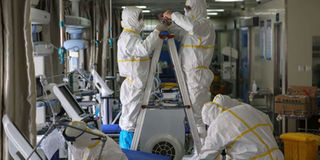Covid-19 most infectious during the first week, says experts

Medical staff seal a vent at a ward used to be an isolation ward for patients infected by the Covid-19 coronavirus at a hospital in Wuhan in China's central Hubei province on March 12, 2020. PHOTO | STR | AFP
What you need to know:
The new study has not been published in a peer- reviewed journal, meaning that the external specialists have not yet examined it for quality and accuracy.
Research regulations requires that such a study be evaluated before it is given a clean bill of health to be used as guide to clinical practice.
As experts step up research to fight the fast spreading new coronavirus, focus is now on delaying the spread of the deadly disease at its initial stages rather than trying to contain it.
Since January, when the World Health Organization (WHO) declared the coronavirus outbreak a global public health emergency and later a pandemic, research about the new coronavirus has been gathering momentum.
According to a new preliminary research, the new coronavirus is at its most infectious during the first week after a person has contracted it.
MOST INFECTIOUS
Recent studies conducted by researchers from Bundeswehr Institute of Microbiology in Munich, the Klinikum Munchen-Schwabing, Charite Universitatsmedizin Berlin, and University Hospital LMU Munich, all in Germany- found out when the virus is most infectious.
According to a report in the United Kingdom- based Medical News Today, the new study is yet to be published in a peer- reviewed journal, meaning that the external specialists have not yet examined it for quality and accuracy.
Research regulations requires that such a study be evaluated before it is given a clean bill of health to be used as guide to clinical practice.
However, their findings may have impact on care strategy especially how the virus was spreading at different stages of infection, and through what mediums.
The researchers analysed various samples collected from nine individuals who had contracted Severe Acute Respiratory Syndrome Coronavirus 2 (SARS-COV-2).
TREATMENT
The nine individuals were people who had attended a hospital in Munich for diagnostic and treatment, and they all experienced mild symptoms.
“All of these individuals were young to middle –aged adults who had no significant underlying health conditions,” said the report.
The report further says that the researchers analysed samples of saliva and mucus, as well as blood, urine, and stool collected at various stages of the infection.
The researchers tested each of them to see if the virus was present, and if it had the ability to infect further.
“Samples from the patients’ throats revealed that the virus was most infectious during the first week after the person had contracted it. This was the case with 16.66 per cent of throat swabs and 83.33 per cent sputum (saliva and mucus) samples,” said the experts in their preprint of the research paper.
Attempts by the researchers to isolate the virus in samples that they collected after the eighth day from a person’s exposure to the virus was not successful.
URINE SAMPLES
At the same time, the research revealed that blood and urine samples did not present any virus traces while stool samples did not show any viral Ribonucleic Acid (RNA) virus as its genetic material.
The researchers also created a viral culture from the virus RNA present in stool, which suggests that this may be an unlikely source of infection.
“The prolonged viral shedding in sputum is relevant not only for hospital infection control but also for discharge management,” the researcher writes.
Experts says the researchers’ findings is a wakeup call to hospital facilities handling new cases to avoid hospital bed shortage by discharging people from the hospital early on and advising self-isolation.
ISOLATION
“In a situation characterised by limited capacity of hospital beds in infectious disease wards, there is pressure for early discharge following treatment. Based on the present findings, early discharge with ensuing home isolation could be chosen for patients who are beyond day 10 of symptoms,” the researchers write.
The clinical presentation and virological assessment of hospitalised cases of coronavirus disease was conducted by 17 experts led by Roman Woelfel from Bundeswehr Institute of Microbiology.
China was the epicentre of the outbreak that has so far infected more than 120,000 people globally and killed at least 4,500 so far.
According to the World Health Organization, the disease has spread to 114 countries so far. Of these, seven are in sub-Saharan Africa with DR Congo being the latest country to confirm a case.





